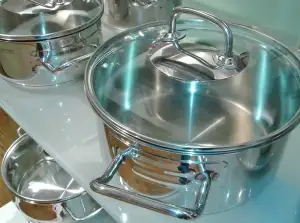Effortless Cast Iron Pan Cleaning: A Step-by-Step Guide for a Spotless Kitchen

- Gather necessary cleaning supplies: hot water, mild dish soap, scrub brush, paper towels, and a towel
- Allow the pan to cool down completely before cleaning
- Rinse the pan with hot water to remove loose debris
- Use a mild dish soap and a scrub brush to gently scrub the pan's surface
- Avoid using abrasive cleaners or metal scouring pads to prevent damage to the pan's seasoning
- Rinse the pan thoroughly to remove any soap residue
- Dry the pan completely using paper towels or a towel
- Apply a thin layer of oil to the pan's surface to maintain its seasoning and prevent rusting
- Store the pan in a dry place to avoid moisture buildup
- Regularly repeat the cleaning process to keep the cast iron pan in optimal condition
Introduction:
Proper cleaning is crucial for maintaining the longevity and performance of your beloved cast iron pans. These versatile kitchen tools are known for their exceptional heat retention and even cooking, but they require special care to keep them in top shape. Neglecting to clean your cast iron pan properly can result in a loss of its natural non-stick surface, rust formation, and a compromised cooking experience. By following a few simple steps, you can effortlessly clean your cast iron pans and ensure they remain spotless for years to come.
Gather necessary cleaning supplies: hot water, mild dish soap, scrub brush, paper towels, and a towel
To ensure effortless cleaning of your cast iron pan, it's essential to gather the necessary cleaning supplies. You will need hot water, mild dish soap, a scrub brush, paper towels, and a towel. Hot water helps to loosen any food debris stuck on the surface of the pan, while mild dish soap is gentle enough to clean without stripping away the pan's seasoning. The scrub brush will aid in removing any stubborn residue, and paper towels or a towel can be used for drying the pan thoroughly. Having these supplies ready will make the cleaning process quick and efficient.
Allow the pan to cool down completely before cleaning
Allowing the cast iron pan to cool down completely before cleaning is crucial for several reasons. Firstly, cleaning a hot pan can be dangerous and may lead to burns or injuries. Secondly, sudden temperature changes can cause the pan to warp or crack, rendering it unusable. Additionally, allowing the pan to cool down allows any remaining food particles or grease to solidify, making them easier to remove during the cleaning process. So, always exercise caution and patience by letting your cast iron pan cool down completely before proceeding with cleaning.
Rinse the pan with hot water to remove loose debris
After allowing the cast iron pan to cool down completely, the first step in the cleaning process is to rinse it with hot water. This helps to remove any loose debris or food particles that may be stuck to the surface. The hot water helps to loosen and dissolve these particles, making them easier to remove. It is important to use hot water as cold water can cause the pan to contract and potentially warp. By rinsing the pan thoroughly, you ensure that any loose debris is removed before moving on to the next step of cleaning.
Use a mild dish soap and a scrub brush to gently scrub the pan's surface
To effectively clean your cast iron pan, use a mild dish soap and a scrub brush to gently scrub the surface. The soap will help remove any stubborn food particles or residue that may have stuck to the pan during cooking. Be sure to choose a mild soap to avoid stripping away the pan's seasoning. Gently scrub in circular motions, paying attention to any areas with buildup. This step will help restore the pan's cleanliness while preserving its natural non-stick properties.
Avoid using abrasive cleaners or metal scouring pads to prevent damage to the pan's seasoning
To prevent damage to the pan's seasoning, it is crucial to avoid using abrasive cleaners or metal scouring pads. These harsh cleaning tools can strip away the protective layer of seasoning that develops over time, compromising the pan's non-stick properties. Instead, opt for a mild dish soap and a soft scrub brush to gently remove any food residue. This method will effectively clean the pan without causing any harm to its surface. By avoiding abrasive cleaners and metal scouring pads, you can maintain the integrity of your cast iron pan's seasoning and ensure its longevity.
Rinse the pan thoroughly to remove any soap residue
After scrubbing the cast iron pan with mild dish soap, it is crucial to rinse it thoroughly to remove any soap residue. Soap residue can affect the flavor of future dishes cooked in the pan and may even cause a soapy taste. Additionally, leaving soap residue on the pan can lead to a sticky or gummy surface. To ensure a spotless finish, rinse the pan under hot water until all traces of soap are gone. This step is essential for maintaining the integrity of the seasoning and preserving the natural non-stick properties of the cast iron pan.
Dry the pan completely using paper towels or a towel
After rinsing the pan thoroughly, it is important to dry it completely to prevent any moisture from causing rust. To do this, you can use paper towels or a clean towel. Gently pat the surface of the pan until it is completely dry. Make sure to pay attention to any crevices or corners where water might be trapped. Properly drying the pan will ensure that it remains in good condition and ready for future use.
Apply a thin layer of oil to the pan's surface to maintain its seasoning and prevent rusting
After drying the pan completely, it is crucial to apply a thin layer of oil to its surface. This step helps maintain the seasoning, which is essential for the non-stick properties of cast iron pans. Additionally, the oil acts as a protective barrier against rusting. To apply the oil, simply pour a small amount onto a paper towel and rub it all over the pan's interior and exterior. Make sure to coat every inch of the surface evenly. This simple step will go a long way in preserving your cast iron pan and ensuring its longevity.
Store the pan in a dry place to avoid moisture buildup
After cleaning your cast iron pan, it is crucial to store it in a dry place to prevent moisture buildup. Moisture can lead to rust formation, which can damage the pan's surface and compromise its performance. To ensure longevity and optimal condition, find a cool and dry spot in your kitchen or pantry for storing the pan. Avoid storing it near the sink or any other area prone to moisture. Additionally, consider placing a paper towel or cloth between stacked pans to absorb any residual moisture and prevent contact between them. By storing your cast iron pan properly, you'll maintain its quality and be able to enjoy its cooking benefits for years to come.
Regularly repeat the cleaning process to keep the cast iron pan in optimal condition
Regularly repeating the cleaning process is crucial to maintaining the optimal condition of your cast iron pan. Over time, cooking residues and oils can build up on the surface, affecting its performance and potentially leading to rusting. By regularly cleaning your pan, you ensure that it remains free from debris and maintains its natural non-stick properties. This will not only enhance your cooking experience but also prolong the lifespan of your cast iron pan. Make it a habit to clean your pan after each use, following the step-by-step guide outlined earlier. With consistent care, your cast iron pan will continue to deliver exceptional results for years to come.
In conclusion, proper cleaning is essential for maintaining the longevity and performance of your cast iron pans. By following the step-by-step guide outlined in this article, you can ensure that your pans remain in optimal condition for years to come. Regular cleaning helps to remove food debris, prevent rusting, and maintain the pan's seasoning, which enhances its non-stick properties. Neglecting proper cleaning can lead to a buildup of residue and damage to the pan's surface. So make it a habit to clean your cast iron pans after each use, and store them in a dry place to avoid moisture buildup. With consistent care, your cast iron pans will continue to provide you with delicious meals for generations.
Published: 18. 02. 2024
Category: Home



